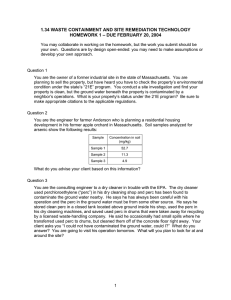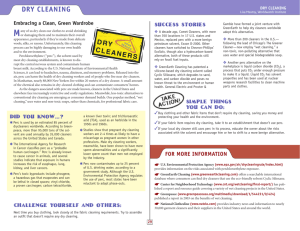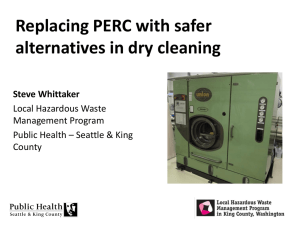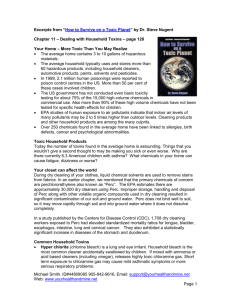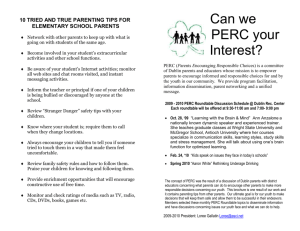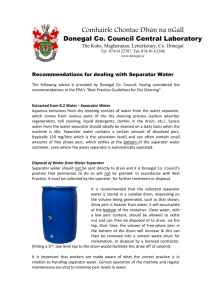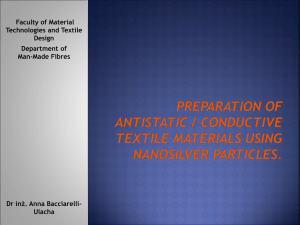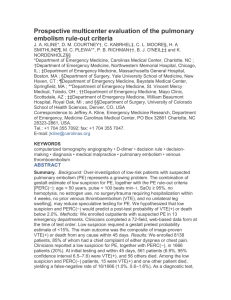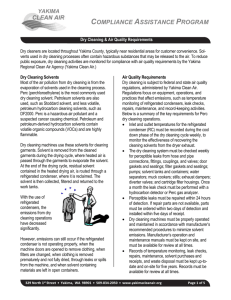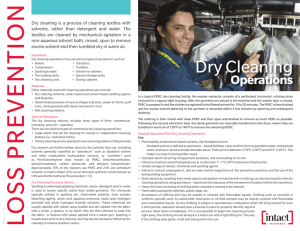Dry Cleaners - Yakima Regional Clean Air Agency
advertisement
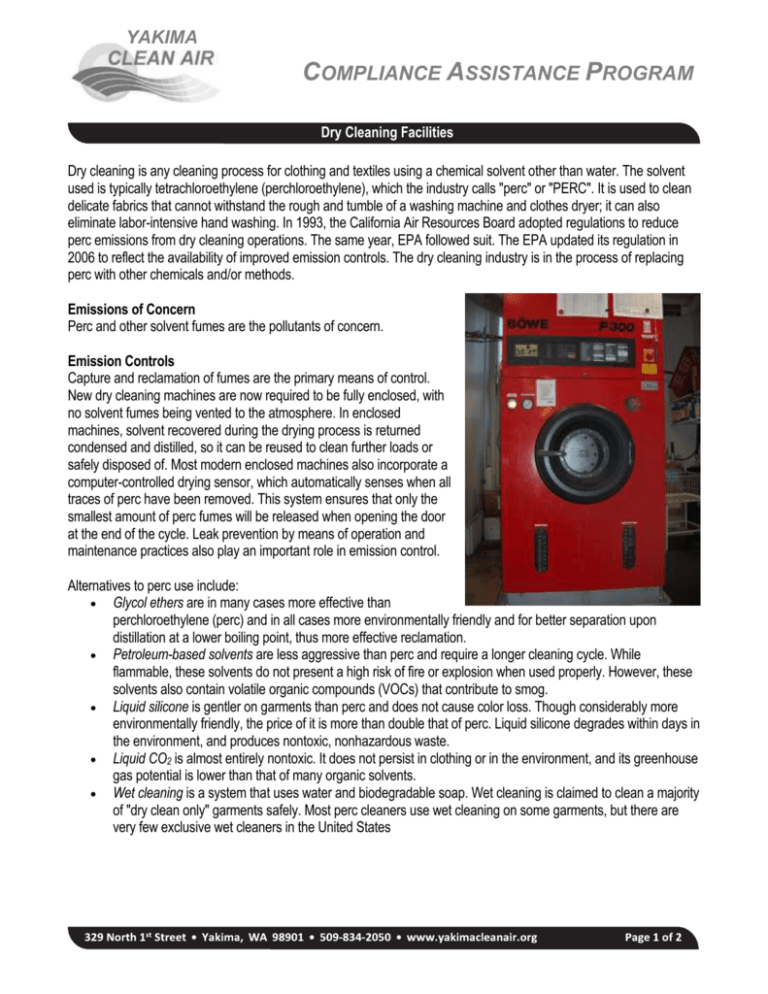
YAKIMA COMPLIANCE ASSISTANCE PROGRAM Dry Cleaning Facilities Dry cleaning is any cleaning process for clothing and textiles using a chemical solvent other than water. The solvent used is typically tetrachloroethylene (perchloroethylene), which the industry calls "perc" or "PERC". It is used to clean delicate fabrics that cannot withstand the rough and tumble of a washing machine and clothes dryer; it can also eliminate labor-intensive hand washing. In 1993, the California Air Resources Board adopted regulations to reduce perc emissions from dry cleaning operations. The same year, EPA followed suit. The EPA updated its regulation in 2006 to reflect the availability of improved emission controls. The dry cleaning industry is in the process of replacing perc with other chemicals and/or methods. Emissions of Concern Perc and other solvent fumes are the pollutants of concern. Emission Controls Capture and reclamation of fumes are the primary means of control. New dry cleaning machines are now required to be fully enclosed, with no solvent fumes being vented to the atmosphere. In enclosed machines, solvent recovered during the drying process is returned condensed and distilled, so it can be reused to clean further loads or safely disposed of. Most modern enclosed machines also incorporate a computer-controlled drying sensor, which automatically senses when all traces of perc have been removed. This system ensures that only the smallest amount of perc fumes will be released when opening the door at the end of the cycle. Leak prevention by means of operation and maintenance practices also play an important role in emission control. Alternatives to perc use include: Glycol ethers are in many cases more effective than perchloroethylene (perc) and in all cases more environmentally friendly and for better separation upon distillation at a lower boiling point, thus more effective reclamation. Petroleum-based solvents are less aggressive than perc and require a longer cleaning cycle. While flammable, these solvents do not present a high risk of fire or explosion when used properly. However, these solvents also contain volatile organic compounds (VOCs) that contribute to smog. Liquid silicone is gentler on garments than perc and does not cause color loss. Though considerably more environmentally friendly, the price of it is more than double that of perc. Liquid silicone degrades within days in the environment, and produces nontoxic, nonhazardous waste. Liquid CO2 is almost entirely nontoxic. It does not persist in clothing or in the environment, and its greenhouse gas potential is lower than that of many organic solvents. Wet cleaning is a system that uses water and biodegradable soap. Wet cleaning is claimed to clean a majority of "dry clean only" garments safely. Most perc cleaners use wet cleaning on some garments, but there are very few exclusive wet cleaners in the United States • • • YAKIMA COMPLIANCE ASSISTANCE PROGRAM New Source Review (NSR) & Fees YRCAA requires that a NSR permit application be submitted and approved prior to the construction, installation, establishment, replacement or modification of air contaminant sources, emissions units or air pollution control equipment in YRCAA jurisdiction. This includes equipment associated with stationary or portable devices or any part of such a device that emits or has the potential to emit any air contaminant, including dry cleaners. There is a NSR permit application fee, and an Order of Approval fee, based on the staff time to conduct the review and draft the Order of Approval. Annual Registration & Fees Sources of air contaminants, including dry cleaners, must register annually with YRCAA and pay a fee. YRCAA’s Board of Directors reviews fees annually. For current fees, click here. As a part of the registration program, businesses are required to complete and submit a registration form annually. The annual registration program enables YRCAA to classify sources and maintain an inventory of air contaminants. Information is also used to evaluate air pollution control strategies to attain and maintain National Ambient Air Quality Standards. Inspections Regular inspections of registered sources are conducted to verify compliance with air pollution regulations. When inspecting dry cleaners, the compliance team will: review records; determine if any changes have been made to processes, equipment, materials or fuels; observe operation and maintenance activities; determine if any violations of rules, permits or orders exist; and determine if any corrective actions are needed to avoid enforcement. If you have already installed or modified a dry cleaner, or any equipment or process associated with a dry cleaner, or are planning to in the future, please contact YRCAA. Our staff is available to assist you with the permit and registration process. YRCAA Rules YRCAA Regulation 1, Subsection 3.02 YRCAA Regulation 1, Subsection 4.01 State Rules WAC 173-400 – General Regulations for Air pollution Sources WAC 173-460 – Controls for New Sources of Toxic Air Pollutants Federal Rules EPA has rules for control of hazardous air pollutants (HAPs) called maximum achievable control technology (MACT) standards. To determine if your facility, equipment or operation is subject to a MACT standard see the following links: http://www.epa.gov/airtoxics/mactfnlalph.html http://www.epa.gov/ttn/atw/area/compilation.html • • •
